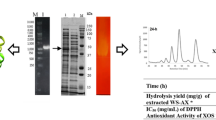Abstract
We constructed recombinant Saccharomyces cerevisiae harboring the xylose isomerase (XI) gene isolated from Clostridium phytofermentans to metabolize xylose and use it as a carbon and energy source. In this study, the effect of supplementation using co-substrate such as glucose or galactose on xylose utilization was studied in recombinant S. cerevisiae. Glucose, which is transported with high affinity by the same transport system as is xylose, was not affected by the heterologous expression of XI, thus xylose utilization was not observed in recombinant S. cerevisiae. However, supplemental galactose added to the recombinant S. cerevisiae stimulated xylose utilization as well as the expression of XI protein. Recombinant S. cerevisiae consumed up to 23.48 g/L of xylose when grown in media containing 40 g/L of xylose and supplemented with 20 g/L of galactose. These cells also produced 15.89 g/L of ethanol. Therefore, expression of the bacterial XI in recombinant S. cerevisiae was highly induced by the addition of supplemental galactose as a co-substrate with xylose, and supplemented galactose enabled the yeast strain to grow on xylose and ferment xylose to ethanol.
Similar content being viewed by others
References
Hahn-Hägerdal, B., K. Karhumaa, C. Fonseca, I. Spencer-Martins, and M. F. Gorwa-Grauslund (2007) Towards industrial pentose-fermenting yeast strains. Appl. Microbiol. Biotechnol. 74: 937–953.
Matsushika, A., H. Inoue, T. Kodaki, and S. Sawayama (2009) Ethanol production from xylose in engineered Saccharomyces cerevisiae strains: Current state and perspectives. Appl. Microbiol. Biotechnol. 84: 37–53.
Van Vleet, J. H. and T. W. Jeffries (2009) Yeast metabolic engineering for hemicellulosic ethanol production. Curr. Opin. Biotechnol. 20: 300–306.
Walfridsson, M., M. Bao, M. Anderlund, G. Lilius, L. Bülow, and B. Hahn-Hägerdal (1996) Ethanolic fermentation of xylose with Saccharomyces cerevisiae harboring the Thermus thermophilus xylA gene, which expresses an active xylose (glucose) isomerase. Appl. Environ. Microbiol. 62: 4648–4651.
Kuyper, M., H. R. Harhangi, A. K. Stave, A. A. Winkler, M. S. Jetten, W. T. Laat, J. J. Ridder, H. J. Op den Camp, J. P. van Dijken, and J. T. Pronk (2003) High-level functional expression of a fungal xylose isomerase: The key to efficient ethanolic fermentation of xylose by Saccharomyces cerevisiae? FEMS Yeast Res. 4: 69–78.
Eliasson, A., C. Christensson, C. F. Wahlbom, and B. Hahn-Hagerdal (2000) Anaerobic xylose fermentation by recombinant Saccharomyces cerevisiae carrying XYL1, XYL2, and XKS1 in mineral medium chemostat cultures. Appl. Environ. Microbiol. 66: 3381–3386.
Zaldivar, J., J. Nielsen, and L. Olsson (2001) Fuel ethanol production from lignocellulose: A challenge for metabolic engineering and process integration. Appl. Microbiol. Biotechnol. 56: 17–34.
Chen, Z., Z. Li, and N. Yu (2010) Expression and secretion of a single-chain sweet protein, monellin, in Saccharomyces cerevisiae by an alpha-factor signal peptide. Biotechnol. Lett. 33: 721–725.
Kotter, P., R. Amore, C. P. Hollenberg, and M. Ciriacy (1990) Isolation and characterization of the Pichia stipitis xylitol dehydrogenase gene, XYL2, and construction of a xylose-utilizing Saccharomyces cerevisiae transformant. Curr. Genet. 18: 493–500.
Brat, D., E. Boles, and B. Wiedemann (2009) Functional expression of a bacterial xylose isomerase in Saccharomyces cerevisiae. Appl. Environ. Microbiol. 75: 2304–2311.
Warnick, T. A., B. A. Methe, and S. B. Leschine (2002) Clostridium phytofermentans sp nov., a cellulolytic mesophile from forest soil. Int. J. Syst. Evol. Microbiol. 52: 1155–1160.
Chung, B. H., D. J. Seo, and S. W. Nam (1999) High-level secretory production of recombinant human lipocortin-I by Saccharomyces cerevisiae. Proc. Biochem. 35: 97–101.
Sambrook, J., E. F. Fritsch, and T. Maniatis (2001) Molecular cloning: A laboratory manual. Cold Spring Harbor Laboratory Press, Cold Spring Harbor, NY, USA.
Choi, G. W., S. K. Moon, H. W. Kang, J. Min, and B. W. Chung (2009) Simultaneous saccharification and fermentation of sludgecontaining cassava mash for batch and repeated batch production of bioethanol by Saccharomyces cerevisiae CHFY0321. J. Chem. Technol. Biotechnol. 84: 547–553.
Han, J. H., J. Y. Park, H. W. Kang, G. W. Choi, B. W. Chung, and J. Min (2010) Specific Expression patterns of xyl1, xyl2, and xyl3 in response to different sugars in Pichia stipitis. J. Microbiol. Biotechnol. 20: 946–949.
Jeffries, T. W. and Y. S. Jin (2004) Metabolic engineering for improved fermentation of pentoses by yeasts. Appl. Microbiol. Biotechnol. 63: 495–509.
Jeffries, T. W. (2006) Engineering yeasts for xylose metabolism. Curr. Opin. Biotech. 17: 320–326.
Garcia Sanchez, R., B. Hahn-Hägerdal, and M. F. Gorwa-Grauslund (2010) Cross-reactions between engineered xylose and galactose pathways in recombinant Saccharomyces cerevisiae. Biotechnol. Biofuels 3: 19.
Ho, N., W. Z. Chen, and A. P. Brainard (1998) Genetically engineered Saccharomyces yeast capable of effective cofermentation of glucose and xylose. Appl. Environ. Microbiol. 64:1852–1859.
Maya, D., M. J. Quintero, M. D. Munoz-Centeno, and S. Chavez (2008) Systems for applied gene control in Saccharomyces cerevisiae. Biotechnol. Lett. 30: 979–987.
Boles, E. and C. P. Hollenberg (1997) The molecular genetics of hexose transport in yeasts. FEMS Microbiol. Rev. 21: 85–111.
Hamacher, T., J. Becker, M. Gárdonyi, B. Hahn-Hägerdal, and E. Boles (2002) Characterization of the xylose-transporting properties of yeast hexose transporters and their influence on xylose utilization. Microbiol. 148: 2783–2788.
Author information
Authors and Affiliations
Corresponding authors
Rights and permissions
About this article
Cite this article
Park, JY., Park, D.J., Chung, BW. et al. Expression of bacterial xylose isomerase in Saccharomyces cerevisiae under galactose supplemented condition. Biotechnol Bioproc E 18, 528–532 (2013). https://doi.org/10.1007/s12257-012-0669-y
Received:
Revised:
Accepted:
Published:
Issue Date:
DOI: https://doi.org/10.1007/s12257-012-0669-y




